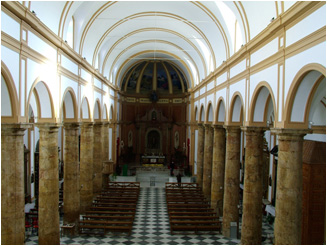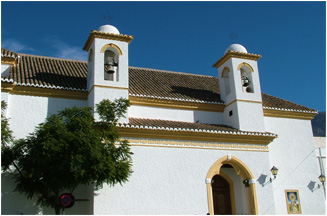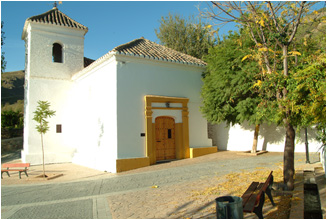Religious
Iglesia de la Anunciación (Church of the Annunciation)
This is one of the larger Churches in the Province. Over 500 years of its history the local Parish has continued to grow, spreading out from the old Church until it was destroyed in the earthquake of 1804 (The Churches foundations lay over those of an Arab Mosque). The rebuilding took place during the mining boom years and the current structure shows that no cost was spared. It is an exceptional example from the neoclassical period of Almería, built around a large Basilica with three aisles separated by large pillars made from Tuscan stone. The central aisle is covered by a half barrelled vaulted ceiling while the lateral aisles have vaulted ceilings. The external façade highlights the twin towers that frame the central body and porch with columns. It is topped with a limestone pediment taken from a local quarry, the ‘Buenavista’ in Los Cerrillos.
Among the Altarpieces that adorn this Church, a few must be given special mention; that of Saint Joseph, made from marble taken from the Balsaplata local quarry; The painting of the twins of the Immaculate Conception and Jesus’ Heart by Domingo Sánchez Mesa; and finally the main Altar, made by Nicolás de Prados and holding the image of the Patron Saint of Berja, Saint Tesifón.
Standing out for their sheer quality from amongst the Churches images and artwork are that of The Nazarene by Espinosa Cuadros; The Virgin of Solidarity (José Maria Aguilar); The Virgin of Fatima (José Ferreira) and that of Saint Francisco (Eduardo Espinosa). From those works made from gold, it is necessary to highlight ‘The Sagrario’ a work by the Valencian Salvador Peris from 1958.
Photo. Interior of the Church of the Annunciation [To extend]
[To extend]
Ermita de Nuestra Señora la Virgen de Gádor (Chapel of the Virgin of Gádor)
Founded in 1588AD this chapel is found in the beautiful setting of Pixnela. It is situated to the North East of the town centre at the foot of the mountain range from where it takes its’ name and is one of the most important sites for pilgrims and pilgrimages for the Diocese of Almería.
The main body of the Chapel is covered by a type of false, half barrelled vaulted ceiling made of wood, canes and plaster. This body is divided into four main areas divided by pillars which join to arches by the use of a cornice. Within the building you can find a number of smaller chapels, the main one with the altar and an area for the choir. Those opening from the main body are very small in depth. Stored here is the impressive figure of the Patroness of Berja, Our Lady of Gádor. It is kept in a small side room of considerable architectural importance. It was built in the middle of the 18th century and is highly decorated.
Regarding the interior decoration of the chapel it is important to note the large wall mounted carving behind the main altar. Designed and built by Eduardo Espinosa in 1939 it is ‘neobarroco’ in style, as are the frescos that decorate the main body, pained in 1927 by the painter Juan Navarrete from Granada.
Standing out amongst the exterior architecture is the side entrance as it is this flank that is first seen when approaching the chapel. It was built at the end of the 1920s and is typical of the neogothic style with a clover styled ‘3 leaf arch’. From the entrance portico twin bell towers rise and appear to have taken their inspiration from the main Church of the Annunciation.
Photo. Chapel of the Virgin of Gádor [To extend]
[To extend]
Ermita de San Tesifón (Saint Tesifón Chapel)
This chapel is found in the Castala area, approximately 6km from the centre of Berja and at the foot of the ‘Sierra de Gádor’ mountain range. It was built in the 17th century and is typical of the Mudéjar style (Mudéjar -Spanish Muslim living under Christian rule) and is made up of a single, small, rectangular room. The walls are made using the ‘tapial’ (packed dirt, sand and lime) technique over masonry foundations. The exterior of the chapel is decorated using a technique described as ‘sgraffito’ – a form of scratching through various surfaces to reveal the colours beneath.
The chapel tower at the head of the building is made up of two bodies, the lower part and the bell tower on top, divided by a cornice located at the same height as the eaves of the building.
The interior of the chapel is made up of one area where the altar is defined by a small rise in ground level. The ceiling is made from a mix of canes and plaster, divided into four rectangular spaces supported by wooden beams.
Photo. Saint Tesifón Chapel [To extend]
[To extend]